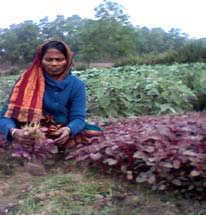Overpopulated, largely poor, and environmentally degraded, the nation of Bangladesh has known its share of woes. Yet even in face of struggles, including a forest loss of over 90 percent, the women of Bangladesh are aiding the country’s struggling people and biodiversity through the establishment of some 20 million homegardens. Long-neglected by the government and NGOs, these homegardens provide food, firewood, and medicine.
A new paper published in the open access journal Tropical Conservation Science explores the participation of women in homegarden management activities in Bangladesh. The paper looks at the impact of homegardens on women’s incomes and livelihood, while assessing the Bangladeshi women’s awareness of how homegardens support biodiversity and environmental sustainability, including reducing pressure on the remaining forests.
 Bangladesh woman working in homegarden. |
Through interviews, the study finds that men and women share duties in the homegarden, but women spend on average more time. Reasons for starting a homegarden include substantial benefits, such as food security, extra income from selling products, health care through herbal medicines, and environmental services.
The homegardens not only provide families with better economic circumstances, but help sustain livelihoods across communities, preserve agricultural biodiversity, and aid beleaguered forests.
The study recommends that governments and international organizations recognize the value of homegardens and work to aid families to continue the positive practice through education and incentives.
Citation: Akhter, S., Alamgir, M., Sohel, M. S. I., Rana, M. P. and Chowdhury, M. S. H. 2010. The role of women in traditional farming systems as practiced in homegardens: a case study in Sylhet Sadar Upazila, Bangladesh. Tropical Conservation Science Vol. 3(1):17-30.
Related articles
Last chance to save Bangladeshi forest: 90 percent of the Sal ecosystem is gone
(03/29/2010) Considered the most threatened ecosystem in Bangladesh, the moist deciduous Sal forest (Shorea robusta) is on the verge of vanishing. In 1990 only 10 percent of the forest cover remained, down from 36 percent in 1985 according to statistics from the Food and Agricultural Organization (FAO). A new study in the online open-access journal Tropical Conservation Science looks at the threats posed to the Shal forest and ways in which it may still be saved.
Bangladesh tops list of most vulnerable countries to climate change
(12/09/2009) According to the Global Climate Risk Index, Bangladesh is the most vulnerable nation to extreme weather events, which many scientists say are being exacerbated by climate change. From 1990 to 2008, Bangladesh has lost 8,241 lives on average every year due to natural disasters. In addition, rising sea levels also threaten millions of Bangladeshis.
UN: Population growth rates fall to 1.1 percent in Asia-Pacific
(05/19/2009) The population growth rate in the Asia-Pacific region has dropped to 1.1 percent, according to the Statistical Yearbook for Asia and the Pacific 2008, compiled by the UN’s Economic and Social Commission for Asia and the Pacific (ESCAP). The 1.1 percent growth rate is the lowest in the developing world.